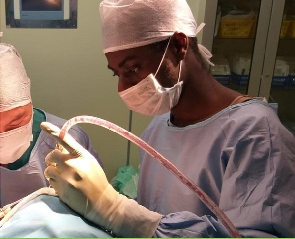Health News of Thursday, 2 November 2023
Source: Simon Badu, Contributor
Advancements in surgery: A lifeline for stroke patients
Stroke is a medical emergency that can happen suddenly and is one of the main causes of death and long-term disability globally. Although prompt intervention has always been essential, stroke victims now have a far better prognosis thanks to recent improvements in surgical methods.
Revascularization anastomosis, carotid endarterectomy, and hematoma removal are a few of these innovative surgical techniques that are giving many stroke survivors hope and a fresh start in life.
Revascularization anastomosis is one of the most promising surgical methods for stroke victims. During this process, a new blood vascular connection, or anastomosis, is surgically created in the damaged brain region.
Revascularization attempts to reestablish blood flow to the brain, which lowers the chance of long-term damage after a stroke. For ischemic strokes, which happen when the blood supply to the brain is cut off, frequently because of a blood clot, revascularization is especially beneficial. This surgical method provides a lifeline for the brain to heal by avoiding the obstruction, which may prevent serious neurological damage.
Another surgical procedure that has great potential to prevent stroke is carotid endarterectomy, particularly in those who are atherosclerosis-prone. The carotid arteries, which provide blood to the brain, will have plaques, or fatty deposits, removed during this operation.
These plaques may restrict blood flow and raise the possibility of clot development. Carotid endarterectomy improves overall vascular health and lowers the risk of further strokes. This surgical method greatly reduces the chance of a major stroke, making it especially helpful for people who have had mini-strokes or transient ischemic episodes (TIAs).
Blood clots known as hematomas can form in the brain as a result of trauma or vascular anomalies. Intracerebral hematomas can worsen brain injury, raise intracranial pressure, and have potentially lethal consequences in the event of a stroke.
Hematomas can be removed surgically, which not only relieves pressure but also reduces the risk of more brain injury. A key tactic for reducing the effects of both hemorrhagic and ischemic strokes is the prompt detection and surgical excision of hematomas.
The combination of medication and surgery has a tremendously beneficial effect on stroke care. These surgical methods broaden the breadth of treatment and recovery, even while medicinal interventions like antiplatelet medications and thrombolytic therapy are still crucial for the immediate care of strokes.
Furthermore, a major impact on stroke outcomes can be achieved by timely access to surgical procedures, interdisciplinary collaboration, and early detection. Surgeons are becoming more and more important in the treatment of stroke victims, giving them new opportunities for healing and hope when their prognosis could have been dire.
The integration of surgical methods such as carotid endarterectomy, hematoma removal, and revascularization anastomosis is giving stroke survivors and their families renewed hope as the area of stroke care progresses.
The stories of stroke recovery are being rewritten by these operations, which are frequently used in addition to conventional medical care and allow patients to reconstruct their lives and take back their futures.
With each successful procedure, the power of surgery in the field of stroke care is helping close the gap between a life-altering impairment and newfound optimism in this era of medical innovation.











